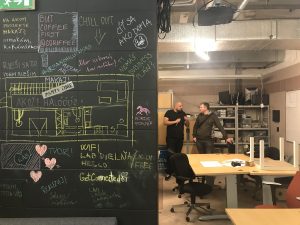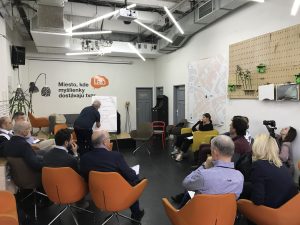5th of November Urban Manufacturing Interreg Europe Final Conference – one to remember
Success factors for great collaborative maker spaces
Unbelievably the Interreg Europe Urban Manufacturing project is already at the end of year 3 of project delivery. This first phase has focused squarely upon knowledge exchange through thematic policy meetings and study visits. The final conference was no exception to this focus on learning, albeit with a dose of fun thrown in with the launch of a collaborative maker space toolkit game – more on this later on…
Particularly illuminating was the key-note speech by Joey Gottbrath, Head of the Jacobs Institute, UC Berkley’s interdisciplinary hub for learning and making – a 24,000 sq. ft equipment/educational labs offering prototyping, iteration and fabrication tools. Joey drew on his experience from the Jacobs Institute, Berkley https://jacobsinstitute.berkeley.edu/; The Crucible (non-for-profit maker space) https://www.thecrucible.org/and Autodesk https://software.berkeley.edu/autodesk, software company to highlight a number of critical success factors for effective collaborative maker space environments.
One of Joey’s key messages was how to facilitate interaction between maker spaces in the locality’s ecosystem. Joey developed the Berkley Yale classification system (based on “A Classification System for Higher Education Makerspaces” by Dr. Vincent Wilczynski, Yale University) to facilitate understanding and communication between maker spaces. Key elements of this included:
- What mission does the space support?
- Accessibility- who can use the space?
- Number of users?
- Size of the makerspace?
- What does the staff structure look like?
 Learning point 2: Reaching out to bring in future makers
Learning point 2: Reaching out to bring in future makers
Collaborative maker spaces can be a powerful way of engaging with local young people. Over the past 20 years, the Crucible has built a vibrant, diverse community with 12,000 people engaging with the space over the course of a year, including connecting with more than 5,000 young people through a range of programs. Gottbrath emphasises that the key to getting young people engaged lies in identifying the right hook. Bikes proved to be the catalyst to make this happen. Young people learned how to customise their bikes through learning how to weld. They achieved something they thought was not possible, resulting in an amazing output. Similarly, the space provides opportunities for children as young as 12-14 years-old to learn the art of glass blowing as well as a chance to learn the ropes of the blacksmithing trade. Not content with resting upon its laurels, waiting for punters to walk through the door, the Crucible converted a fire truck to venture out into the local community to court further local interest. Crucially, every attempt is made to remove the barriers to participation as the Crucible recognises that the future of collaborative making lies in capturing the youth audience.
Learning point 3: Engaging maker space users in the collaborative process
Once you have users through the door, the key is to actively engage with them to ensure they make full use of the collaborative, creative potential of the maker space. Gottbrath emphasised the critical importance of the technicians in providing mentorship and helping to develop a curriculum for users and to engineer connections between students and technicians. Equally, the power of peer-to-peer learning is recognised at the institute and a student worker position was created. This position has proven to be a stroke of genius with users who are less afraid to ask for assistance from a fellow peer. Achieving a good gender balance amongst staff was also cited as a key to success. Clearly the Jacobs Institute are doing something right as they outstrip all of the other major institutions in the US for graduate start-up founders. Berkeley having 240 students raising $1m since 1.05.2018 compared with the second closest UCLA having 85 students. The Jacobs Institute fosters an immersive culture of making with club level maker spaces such as the solar vehicle space or the Formula 1 space. Entry to these clubs is competitive and reflective of start-up reality. The maker spaces are pretty much open all hours (making environmental health and safety bods your ally is a key component in achieving this) and carefully put together instruction booklets ensure there are no reasons to restrict the use of any machine. Attention is also given to raising students’ awareness to the importance of producing a polished product to present to venture capitalists. https://skydeck.berkeley.edu/ has been instrumental in helping hone creators pitch skills and fine tune their products.
 Capturing the imagination of policy makers
Capturing the imagination of policy makers
The conference also provided Urban M with an opportunity for a test run of the maker space game. Designed by Tom Cahill Jones, Development Manager, Institute for Creative Innovation, Birmingham City University, the game helps raise policy makers awareness to the essential elements required to make a successful maker space. By cleverly engineering the options – (you could have a trendy, young male coder interested in making a chair!) the player is forced into thinking about how to accommodate less stereotypical interactions. The game culminates in all 6 players working together to design a maker space taking into account the diverse needs of its members. It is fast paced and fun to play – the downloadable version will be available on the Urban M website at: https://www.interregeurope.eu/urbanm/
In the meantime, if you’ve never ventured into the realm of making here is a fantastic site with many ideas for simple projects which can be achieved with relatively low-tech tools. Enjoy!!
https://www.instructables.com/
For further information, please contact: Heather.Law@birmingham.gov.uk




